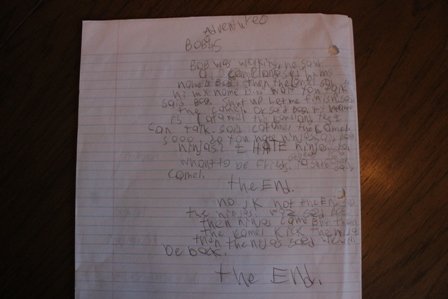Dysgraphia

Quick Facts about Dysgraphia
- A learning disability which makes writing difficult
- Believed to result from weak fine motor skills and difficulty remembering sequences
- Usually results in messy and sometimes illegible hand writing
- Strategies to improve writing include explicit instruction on forming letters and numbers followed by regular, repetitive practicing and writing aids like pencil grips
- Alternatively, assistive technology and the development of keyboarding skills can reduce the need for hand writing
Definition
The word Dysgraphia, is composed of the two Greek root words Dys for difficult and graphia for writing. In short, it's difficulty writing, or even more simply, it's very messy writing, that is often illegible and incomprehensible.
It is a specific learning disability, distinct from dyslexia and Attention Deficit Disorder (ADD) but often occurs together with them.
Symptoms / Signs of Dysgraphia by Age
Children 0-6:
- Awkward pencil grip, and/or an overly tight grip
- Slow and laboured writing - a very taxing activity
- Inconsistent letter shape & size
- Inconsistent sequence of strokes to draw the same letter or number
- Inconsistent spacing between letters, words and sentences (can't stay on/between the lines)
- Poor understanding of upper and lower case letters
Children 7-15:
Adults:
- Messy handwriting
- A dislike for writing, including short notes or cards
- Difficulty with sentence structure and grammar
- Gap between understanding and ability to convey that understanding in print
Causes

The causes are many and include a deficiency in fine motor skills, but in the
case of dyslexic children, the problem results in part from the inability to
remember sequences. At first this sounds
strange because writing a letter may not appear to be a sequence of activities, but it is. Forming a letter involves a sequence of pencil strokes including a starting point, intermediate steps and
an ending point.
For example when writing the capital letter E, you likely have a pattern you follow each time, but there are many sequences available for writing the letter—a line and three dashes, a backwards 3, or an L and two extra dashes. Most writers don't have to think about how to do it, they have a pattern, a sequence that they always do and have always done, but not a dyslexic with a dysgraphic writing deficit. They know the shape they want but can't remember the way to "A" and end up taking odd routes that result in odd letter shapes.

You will know it when you see it!
Strategies for Home and School
- Spend extra time practicing
forming each letter using the same sequence of pencil strokes over and
over. For tips on improving handwriting try this helpful occupational therapy site.
- Teach typing / keyboarding and the use of a word processor
- Praise good writing rather than criticizing messy writing
- Provide more time for writing and emphasize quality over speed
- Allow for oral exams
- Allow for recording devices instead of note taking
- Reduce the amount of copying needed by having notes prepared for students in advance
- Use special pencil grips
- Provide alternatives to
written assignments (video or audio taped reports)
Final Thoughts
Dysgraphia is not simply messy handwriting, but poor writing is usually the most obvious sign. Poor writing can also result from a lack of practice forming letters, poor pencil grip (from lack of practice with a pencil rather than poor fine motor skill) or vision problems. Be sure to rule these out first.
With proper instruction and tools, writing can also be improved and with the use of assistive technology and keyboarding, the need for writing can be reduced or eliminated. In short, with proper accommodations and interventions dysgraphics can become successful writers.
Return to the top of Dysgraphia
- Home ›
- Dysgraphia
New! Comments
Share your thoughts or ideas! Leave us a comment in the box below. You can post it at this site only or on Facebook too, it's up to you.